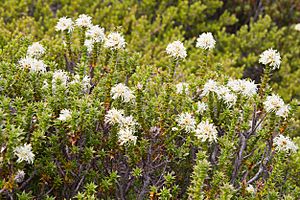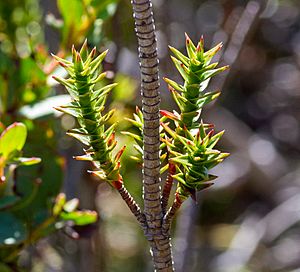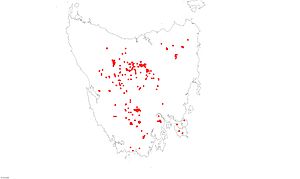Richea sprengelioides facts for kids
Quick facts for kids Richea sprengelioides |
|
|---|---|
 |
|
| Richea sprengelioides in Walls of Jerusalem National Park |
|
| Scientific classification | |
| Genus: |
Richea
|
| Species: |
sprengelioides
|
| Synonyms | |
|
Cystanthe sprengelioides R.Br. |
|
Richea sprengelioides is a type of flowering plant that belongs to the Ericaceae family. It's one of 11 species in the Richea group that are found only in Australia. Out of these, nine species live only in Tasmania.
This plant was first officially described by a botanist named Robert Brown in 1810. He called it Cystanthe sprengelioides. Later, in 1867, another botanist, Ferdinand von Mueller, moved it to the Richea group. You can find Richea sprengelioides growing in the mountains across Tasmania.
Contents
What Richea sprengelioides Looks Like
Richea sprengelioides is a shrub that can grow up to 1.2 meters (about 4 feet) tall. Its older stems don't have leaves, but they have many interesting angular marks where leaves used to be. The leaves themselves are special for this plant group. They wrap around the stem before curving outwards and ending in a sharp point.
The flowers of Richea sprengelioides grow in a cluster at the end of the stems. This cluster is about 2 centimeters (less than an inch) wide and tall, with around 20 flowers packed together. The flowers are usually a creamy white color.
How to Tell it Apart from Other Plants
It's usually easy to spot Richea sprengelioides, but it can sometimes be mistaken for a couple of other plants in Tasmania.
One key feature that helps identify R. sprengelioides is the size of its leaves. They are quite small, only 8–12 millimeters long. This is much smaller than the leaves of Richea scoparia, which often grows in the same areas.
Its closest relative is R. procera. R. procera usually grows at lower altitudes (above 400 meters or about 1,300 feet). While these two plants can sometimes be found in the same mid-altitude places, they have different flowers. R. sprengelioides has creamy white flowers, but R. procera has flowers with pink tips. The tiny threads inside the flowers (called filaments) are also different: R. sprengelioides has white, smooth, and thin filaments, while R. procera has yellow, thicker ones.
Another plant that looks very similar is Sprengelia incarnata, though it's not closely related. You can tell them apart by looking at the stems. R. sprengelioides has clear leaf scars on its stem, but S. incarnata does not.
Where Richea sprengelioides Lives
Richea sprengelioides is found in the mountainous areas of western, southwestern, northeastern, and central Tasmania. It is most common in alpine areas, which are high up in the mountains. Here, it usually grows as a small bush among other shrubs. However, if the area is very exposed to wind and weather, it might grow in a much smaller form within grassy alpine fields.
At lower altitudes, you might find it growing in rocky places that are exposed to the elements. Less often, it can be found in woodlands where the soil drains well. The flowers of this plant are a food source for several types of mammals.
Conservation Status and Threats
Richea sprengelioides is found widely across Tasmania, and much of the land where it grows is protected. This plant is not currently listed as endangered by major conservation groups.
However, the alpine heathlands where it commonly lives could change quickly in the coming years. This is because Tasmania's climate is getting warmer. These high-altitude ecosystems are home to many unique plants and animals found nowhere else. So, any changes in these areas are a big concern for the future of species like Richea sprengelioides.



